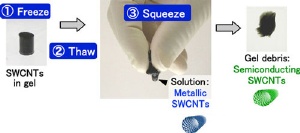Apr 6 2009
Hiromichi Kataura and Takeshi Tanaka, the Self-Assembled Nano-Electronics Group, the Nanotechnology Research Institute of the National Institute of Advanced Industrial Science and Technology (AIST) have developed an easy-to-use method to separate metallic and semiconducting single-wall carbon nanotubes (SWCNTs) using agarose gel.
 Separation of metallic and semiconducting SWCNTs by a freeze, thaw and squeeze method with SWCNTs-containing agarose gel. A solution containing metallic SWCNTs and a gel containing semiconducting SWCNTs are simultaneously obtained by squeezing the SWCNTs-containing gel after freeze and thaw processes.
Separation of metallic and semiconducting SWCNTs by a freeze, thaw and squeeze method with SWCNTs-containing agarose gel. A solution containing metallic SWCNTs and a gel containing semiconducting SWCNTs are simultaneously obtained by squeezing the SWCNTs-containing gel after freeze and thaw processes.
Synthesis of SWCNTs usually results in a 1:2 mixture of metallic and semiconducting ingredients. Further separation of the ingredients is very important for electrical applications, but has been difficult so far.
AIST developed a separation method for metallic and semiconducting SWCNTs with a high yield by means of electrophoresis using agarose gel, as published in February 2008, and has since developed a much more simplified method as described below.
The new method simply freezes, thaws and squeezes SWCNTs-containing agarose gel (Fig. 1). The process is intrinsically simple, can be low-cost method through automation, and is easy to be scaled up. The process will then lead to mass production of metallic and semiconducting SWCNTs.
Part of the results of this study will be published in the U. S. scientific journal Nano Letters on March 11, 2009.